#vodou
Photo

I tried to answer this succinctly, but it turned into an essay. (Sorry.)
The Princess and the Frog was not accurate, strictly speaking, but dinging it for that would be like criticizing the Lion King for not being a realistic wildlife documentary. Accuracy wasn't really the point. Given the fantastical elements and fictional nations like “Maldonia”, I suppose we're meant to understand this as a bit removed from the real New Orleans. It's more a a jazz-flavored fairy tale than a historical fiction.
But for discussion's sake....
Is it fashion-accurate to its 1926 timeframe? Ehhh, sort of. It pays homage to 20s fashion trends with cloche hats, furs and feathery headpieces, but without fully committing to it. The waistline on almost all of Tiana's clothing is too high for the 20s, and the the shapes of her fancier costumes take a lot of liberties, or deviate wildly from the style of the period.
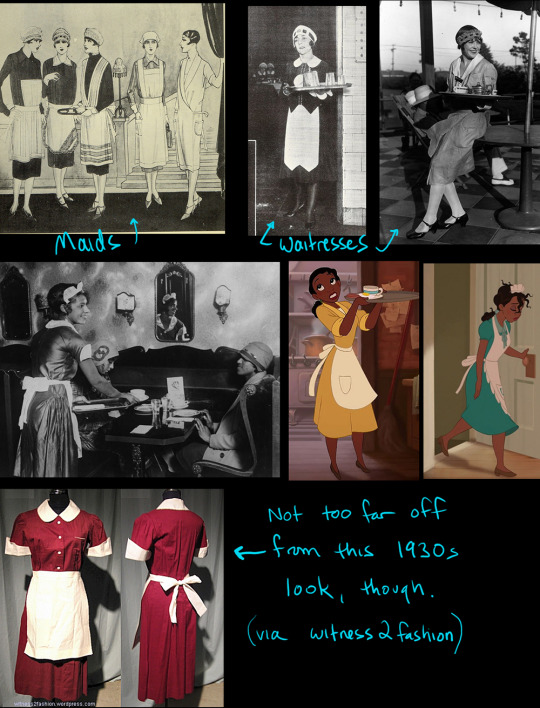
In the 20s, dresses (including workaday stuff) tended to have a straight up-and-down shape to it - kind of a low-waisted rectangle that de-emphasized curves instead of highlighting them. There are valid reasons to play fast and loose with that, though (something I’m definitely guilty of as well). One of those reasons is communication.
For instance, speculatively, the filmmakers wrote Tiana as a hard-working waitress and wanted her to look the part, so they made the choice to clothe her in something familiar - that gingham dress of mid-century shape that we broadly associate with diner waitresses. Actual waitress uniforms of the 20s had a fair bit of overlap with maid uniforms at the time too, and I can see why they wouldn't want to risk the confusion. It's more important to communicate clearly with the larger audience than to appease a small faction of fashion nerds who'd notice or care about the precision.
I don't think it's a case of the designers failing to do their research - I'm sure they had piles of references, and maybe even consultants - but they also had to have priorities.
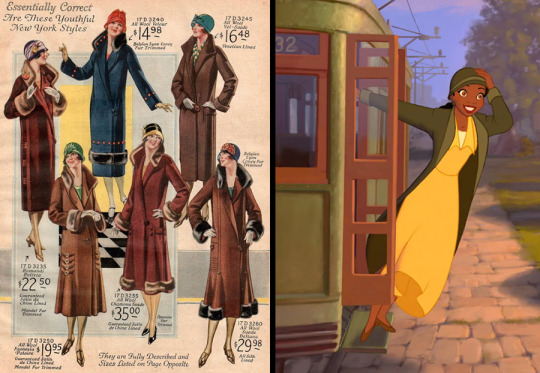
With her hat and coat on, she looks a lot more 1920s-shaped.
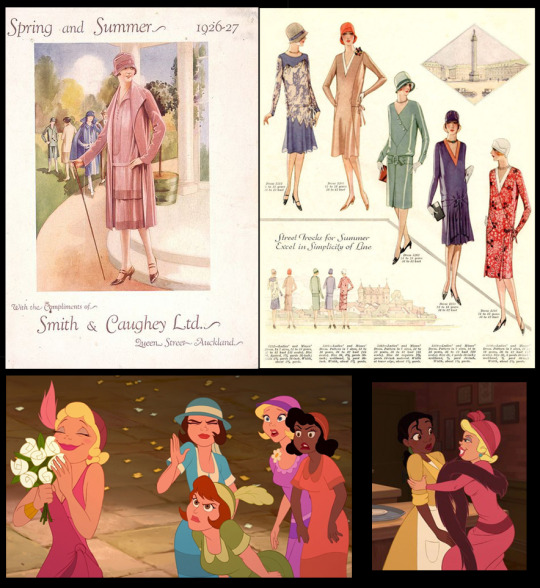
Pretty consistently, the indication of the characteristic 1920s drop waist is there, but the approach otherwise ignores the 20s silhouette. The clothes hug the body too much. This may be about appealing to a 2000s audience, visually speaking, but also could be an animation thing. Maybe both. For practical reasons, clothes in 2d animation are usually more a sort of second skin than something that wears or behaves like realistic fabric.

These are not in the 1920s ballpark at all. Tiana's blue gown looks like your basic Disney brand invention. Strapless things would have been extremely unusual and the overall shape is far out of step. Excusable, I guess, because it's a costume in context. Charlotte looks like she’s heading for a mimosa brunch in a modern maxi dress.
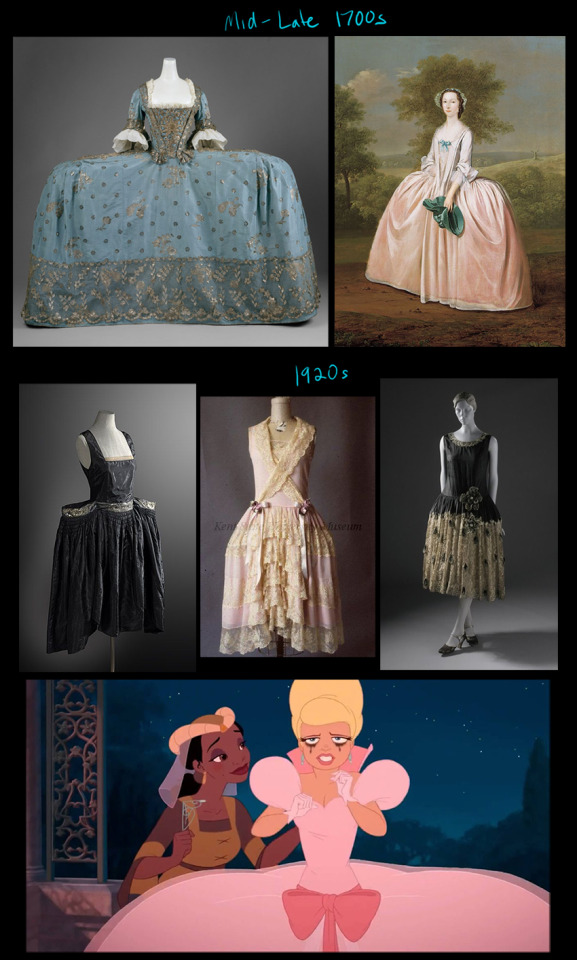
Charlotte's princess dress did seem to be calling back to the ultra-wide pannier side hoops of the 18th century - something that made a reappearance for part of the 20s, albeit in much milder form called robe de style. I'm not sure if the filmmakers were alluding to that at all, really, but either way, her dress is hilarious.
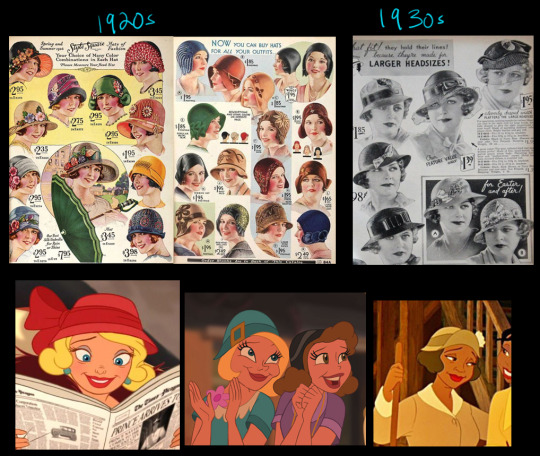
They only went about halfway with the cloche hats. The 1920s cloche really encapsulated the cranium, almost entirely covered bobbed hair, and obscured much of the face from certain angles, so it's easy to see why they've been somewhat reined in for the film. Still, it ends up looking more 1930s, where the hats started to recede away from the face, evolving in the direction of the pillbox.
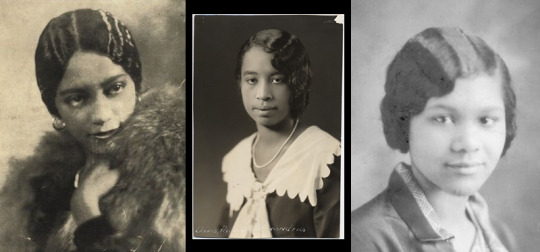
Similarly, Tiana's hair is not very reminiscent of the bobbed, close-to-the-cranium style of the period, but I think that could legitimately be written off as characterization. She's not at all the type of person who'd fuss about going à la mode. Not everyone bobbed and finger-waved their hair.

The clothes Prince Naveen is introduced in are very 1920s collegiate in spirit - the wide-leg oxford bags, the sleeveless pullover sweater, the flat cap, and high, stiff collar. The ukulele and banjolele were pretty trendy instruments at the time too.
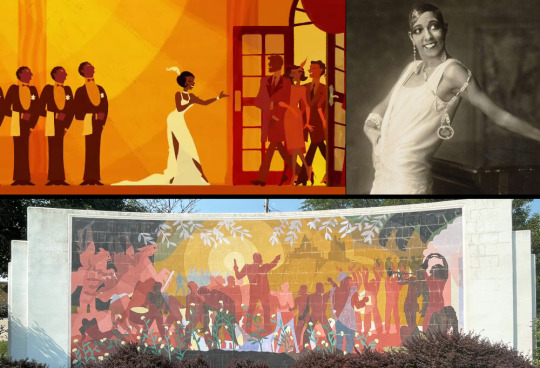
Definitely some Josephine Baker vibes here. Also, the look of this whole fantasy sequence was reportedly inspired by the works of Aaron Douglas, a luminary painter of the Harlem Renaissance known for his depictions of the lives of African-Americans. (The mural is in Topeka, Kansas.)
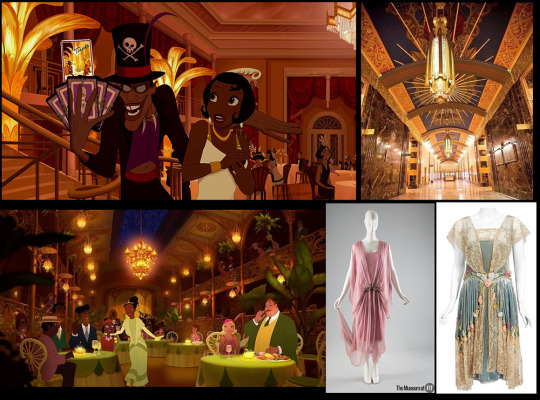
They pretty much nailed the Art Deco. It's gorgeous. Looks somewhat inspired by the interiors of some of the Ralph Walker-designed NYC architecture, plus some French Quarter balcony flair for the final manifestation of Tiana's Place. Her dress here does resemble some gauzy mid-1920s looks, too.
------------------------------------------------
Culturally speaking...
New Orleans is an unusual place. Because some of the colonial Spanish and French laws and conventions that New Orleans evolved under persisted even after its inception into the United States; because it was such a heterogeneous hub of indigenous and immigrant peoples; and because it had a considerable population of free people of color (mostly Creole), it did not function quite like the rest of the South leading up to the Civil War, nor for a while after. Its particular coalescence of cultures made it its own unique sort of culture within the country, within the region, within the state of Louisiana even. By the early 20th century, though, regardless of the not-very-binary nature of New Orleans, Jim Crow laws were enforcing a literal black-and-white distinction, and not an evenhanded one, by far. In that aspect, the city had begun to resemble the rest of the South.
The film nods at the wealth disparity, but goes on to paint a pretty rosy picture of race and class relations at the time. Still it's not unbelievable that some people were exceptions to the rules. You could probably find a few compartments of old New Orleans society that resisted segregation or certain prejudicial norms, preferring to do things their own way. That aside, the film wasn't trying to confront these topics. Not every piece of media should have to. Sometimes breaking away from miserable period piece stereotypes is refreshing. I'm not sure it could have handled that meaningfully given the running time, narrow story focus, and intended audience, anyhow. (But you could perhaps also make a case that family films habitually underestimate younger audiences in this way.)
------------------------------------------------
Raymond the firefly I guess is the film's Cajun representation. There's not much to say about it, except perhaps to note that Evangeline is a reference to the heroine of a Longfellow poem of the same name. The poem is an epic romance set during the expulsion of the Acadians from the eastern provinces of Canada and the northernmost reaches of the American colonies (now Maine) by the British in the mid-1700s. Many exiled Acadians gradually migrated south to francophone-friendly Louisiana, settling into the prairies and bayous, where 'Acadian' truncated into the pronunciation 'Cajun'. Evangeline - who is only finally reunited with her love when he’s on his deathbed - has become an emblem of the heartbreak, separation and faithful hope of that cultural history, and there are parishes, statues and other landmarks named after the her throughout Louisiana.
------------------------------------------------
Voodoo does have a very historical presence in New Orleans, having arrived both directly from West Africa and by way of the Haitian diaspora (where it would more properly be called Vodou). While I don't think Disney's treatment of it was especially sensitive or serious, it also wasn't the grotesquely off-base sort of thing that media of the past has been known to do. It was largely whittled down to a magical plot component, but it wasn't so fully repurposed that it didn't resemble Voodoo at all either - and that's mostly owing to the characters, because it does appear the writers pulled from history there.
It’s apparently widely held that Dr. Facilier is a Baron Samedi caricature - and likely that's true, in part - but I have the impression he's also influenced by Doctor John. Not the 20th century funk musician, but the antebellum “Voodoo King” of New Orleans. Doctor John (also called Bayou John, Jean La Ficelle, and other aliases) claimed to be a Senegalese prince. He became well known as a potion man and romance-focused prognosticator to people from all corners of society. Though highly celebrated and financially successful at his peak, he seems ultimately remembered as an exploitative villain.
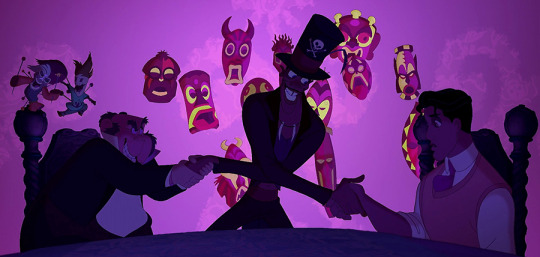
To my recollection, the film sort of gingerly avoids referring to Facilier as a Voodoo practitioner directly (I think he's more generically called a witch doctor in the script?) but it does seem to imply his 'friends on the other side' are a consortium of loa. It's mostly abbreviated into nebulously evil-seeming special FX, glazing over any specificity or dimensionality, but it does also loop back around as a vehicle of moral justice. Loa are all very individualistic and multi-faceted, but they do have reciprocal rules for asking favors of them.
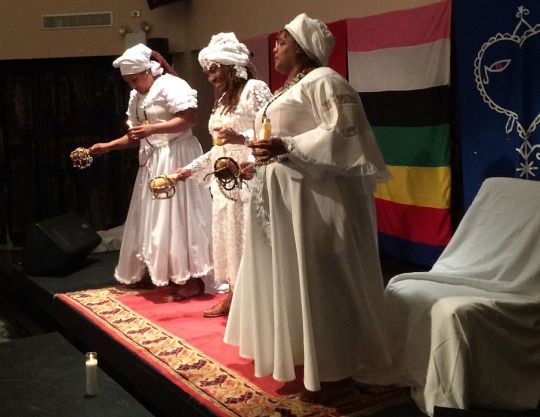
There's also the benevolent counterpart in Mama Odie's character. Her wearing ritual whites has a definite basis in Voodoo/Vodou practice, and her depiction as a fairy godmother-like figure isn't entirely out of step with how a mambo may have been perceived...in a very general sense. They were/are ceremonial leaders and community bastions who people would seek out for help, advice and spiritual guidance. More than just emanating matronly good vibes, though, some have wielded considerable political and economic power.
(Just my opinions here. I've done a lot of reading on the subject for research but I'm no authority with any special insider understanding of Voodoo, and I really shouldn't be relied upon as an arbiter of who has or hasn't done it justice in fiction.)
------------------------------------------------
In summary--
Culturally, I think the film is respectably informed but paints a superficially genteel picture. The set pieces are gorgeous, but the story mostly delivers a sort of veneer of New Orleanishness. And as for fashion, well, it’s the 1920s run through a Disney filter. It’s very pretty, but it’s only as proximally accurate as seemed practical.
I don’t know that any of that really matters so much as whether or not it achieved what it intended, though. As a charming yarn and as a tribute to New Orleans and the Jazz age, I think it’s mostly successful. It’s also really beautifully animated!
#princess and the frog#disney#1920s#new orleans#jazz#fashion#voodoo#vodou#history#animation#art deco
5K notes
·
View notes
Text
The Spirits do not judge you unfairly for your humanity. Your queerness is sacred and divine, your disability is a piece of your holy puzzle and your body is a blessing no matter how it may come.
The Ancestors have lived it, the trees, the hills, the mountains, the sea and the saints have seen it.
The Spirits do not judge you unfairly for your humanity. Imperfection is wholly and entirely perfect.
271 notes
·
View notes
Text



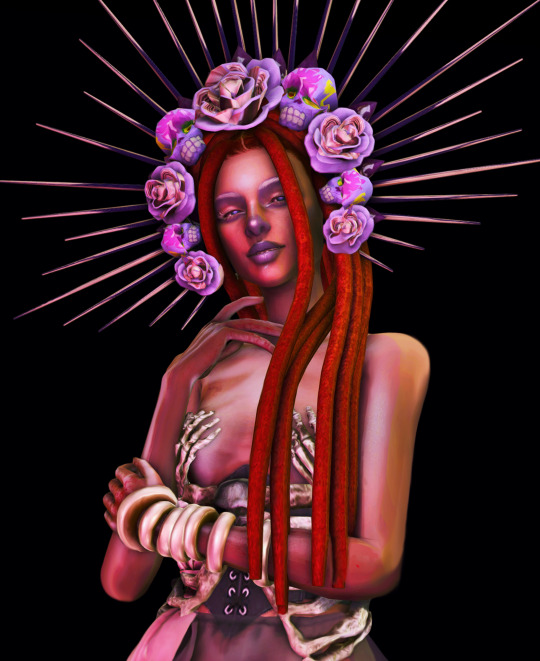

Promt: Voodoo Doll 📍💀
Baron Samedi & Maman Brigitte 💜
#the sims 4#sims 4#vodou#ts4 occult#simstober#simblreen#sims 4 halloween#llamafrightscas#ts4 cas challenge#baron samedi#maman brigitte#SimsHorrorween#sims 4 folklore#sims 4 spellcaster#bobaween#sims 4 mythology#maadhalloween#sims 4 grim reaper
216 notes
·
View notes
Text
On January 7th, we venerate Ancestor & Hoodoo Saint, Auntie Zora Neale Hurston on her 133rd birthday (updated 2024). 🎉
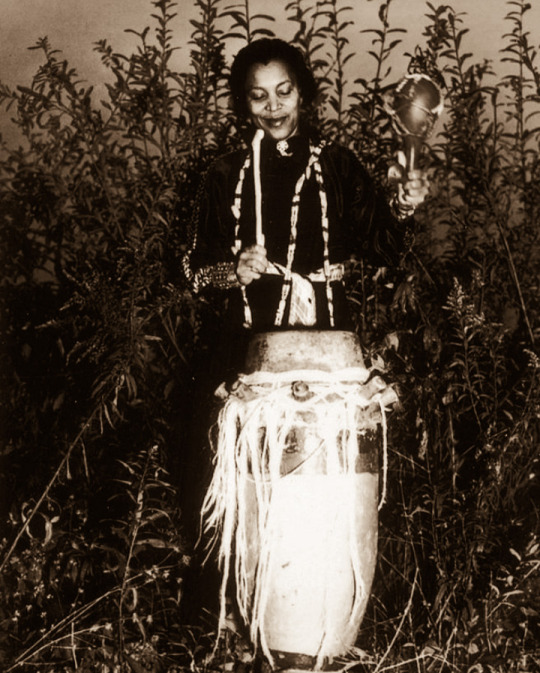
Novelist, Anthropologist, Folklorist, Scholar, Vodou initiate & Historian, Zora Neale Hurston's legacy is forever cemented in Hoodoo Culture (and beyond) as the masterful wordsmith who cast a shining light on black excellence in all everyday forms/spaces, our ATR roots, & the preservation of Black Voices during the prime of the Harlem Renaissance.
Auntie Zora was born in Notasulga, AL and raised on 5 acres of land in Eatonville, FL by her preacher-father and free-spirited mother ; in what would be the first all-Black township in the country. After the shattering loss of her mother, Zora turned up in Baltimore, MD where she presented herself as a 16 year old (10 years her junior) in order to access free public school education resources; thereby finishing school. From then on, Zora lived her life presenting herself as 10 years younger than she actually was. She'd go on to graduate from Barnard College in 1928.
She published several novellas & articles, including "Mules & Men"; a collection of Hoodoo Folklore. She entered the zenith of her career in the late 30s/40s after publishing her masterworks: "Their Eyes Were Watching God", "Tell My Horse", "Moses, Man of the Mountain", & an anthropological study on Hatian Vodou .After publishing her autobiography, "Dust Tracks on a Road, "Auntie Zora finally received the public recognition & literary respect that was long overdue. Despite her successes, and unprecedented contributions in classic literature & anthropology, Zora never received the financial contributions that her work so deserved.
Zora Neale Hurston passed away; penniless, alone, & drifting into obscurity. Friends and supporters from near and far raised $600 for her funeral service and burial. She was buried in an unmarked grave, in a segregated section, at the Garden Of Heavenly Peace Cemetery in Fort Pierce, FL. Over a decade later, in 1973 the Great Alice Walker found the unmarked grave and ordered a headstone to be placed on it; engraved with, "Genius Of The South" in Zora's honor. It remains in place today.
“Let no Negro celebrity, no matter what financial condition they might be in at death, lie in inconspicuous forgetfulness. We must assume the responsibility of their graves being known and honored.” - Zora Neale Hurston to W.E.B. Dubois
Auntie Zora wanted to be remembered & demanded that the same honor and respect be given unto her peers & others. Never forget the infectious voice that defined & defied, inspired & struck fear in many hearts of her time & after.
We pour libations & give 💐 today as we celebrate Auntie Zora for her enigmatic spirit, ancestral wisdom, labor of love for Hoodoo Folklore, & for the seeing the beauty in the dark, sometimes solemn, corners in Black Culture. Let her studies continue to inform our own. Let her spark a fire in us to reconnect to our roots & grow within our lineages.
Offering suggestions: money, music, read/share her work, libations of water, & flowers.
‼️Note: offering suggestions are just that & strictly for veneration purposes only. Never attempt to conjure up any spirit or entity without proper divination/Mediumship counsel.‼️
#hoodoo Saints#Hoodoo Saint#zora neale hurston#Hoodoo#vodou#haitian vodou#the hoodoo calendar#hoodoohistory#hoodoos#atrs#atr#hoodoo culture#bvm#Hoodoo Folklore#Black authors#Black writers#own voices#Black Power
691 notes
·
View notes
Text

STIVENSON MAGLOIRE (HAITIAN, 1963-1994)
#stivenson magloire#haiti#haitian#haitian art#vodou#voodoo#haitian vodou#vodoun#black artist#black art#art naif
252 notes
·
View notes
Text

Gerard Valcin (Haitian, 1923-1988) - Seated Voodoo Priestess (1986)
136 notes
·
View notes
Photo

A manbo (also written as mambo) is a priestess (as opposed to a oungan, a male priest) in the Haitian Vodou religion. Haitian Vodou's conceptions of priesthood stem from the religious traditions of enslaved people from Dahomey, in what is today Benin. For instance, the term manbo derives from the Fon word nanbo ("mother of magic"). Like their West African counterparts, Haitian manbos are female leaders in Vodou temples who perform healing work and guide others during complex rituals.
This form of female leadership is prevalent in urban centers such as Port-au-Prince (the capital of Haiti). Typically, there is no hierarchy among manbos and oungans. These priestesses and priests serve as the heads of autonomous religious groups and exert their authority over the devotees or spiritual servants in their hounfo (temples).
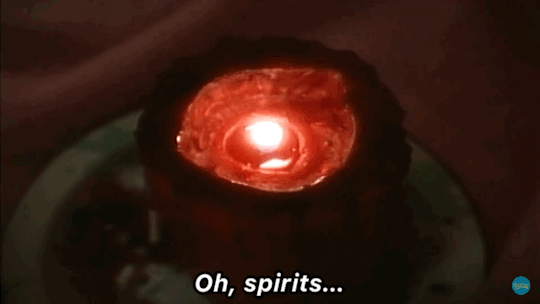
Manbos and oungans are called into power via spirit possession or the revelations in a dream. They become qualified after completing several initiation rituals and technical training exercises where they learn the Vodou spirits by their names, attributes, and symbols.
The first step in initiation is lave tèt (head washing), which is aimed at the spirits housed in an individual's head. The second step is known as kouche (to lie down), which is when the initiate enters a period of seclusion. Typically, the final step is the possession of the ason (sacred rattle), which enables the manbos or oungans to begin their work. One of the main goals of Vodou initiation ceremonies is to strengthen the manbo's konesans (knowledge), which determines priestly power.
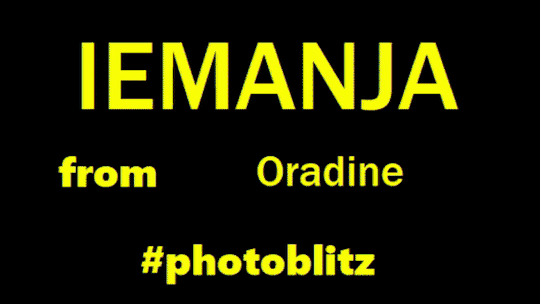
The specific skills and knowledge gained by manbos enable them to mediate between the physical and spiritual realms. They use this information to call upon the spirits through song, dance, prayer, offerings, and/or the drawing of vèvès (spiritual symbols). During these rituals, manbos may either be possessed by a loa (also spelled lwa, Vodou spirits) themselves, or may oversee the possession of other devotees. Spirit possession plays an important role in Vodou because it establishes a connection between human beings and the Vodou deities or spirits. Although loas can "mount" whomever they choose, those outside the Vodou priesthood do not have the skills to communicate directly with the spirits or gods. This is because the human body is merely flesh, which the spirits can borrow to reveal themselves via possession. manbos, however, can speak to and hear from the Vodou spirits. As a result, they can interpret the advice or warnings sent by a spirit to specific individuals or communities.

Cécile Fatiman is a Haitian manbo famously known for sacrificing a black pig in the August 1791 Vodou ceremony at Bois Caïman—an act that is said to have ignited the Haitian Revolution. There are also notable manbos within the United States. Marie Laveau (1801-1888), for example, gained fame in New Orleans, Louisiana, for her personal charm and Louisiana Voodoo practices.
Renowned as Louisiana's "voodoo queen", Laveau's legacy is kept alive in American popular culture (e.g., the television series America Horror Story: Coven).ne Mama Lola is another prominent manbo and Vodou spiritual leader in the United States. She rose to fame after the publication of Karen McCarthy Brown's ethnographic account Mama Lola: A Vodou Priestess in Brooklyn. Mama Lola's success provided her with a platform to challenge Western misconceptions of Haitian Vodou and make television appearances

#kemetic dreams#vodun#cecile fatiman#manbo#bois caiman#manbos#haitian#marie laveau#new orleans#new orleans voodoo#mama lola#vodou#lwa#oungan#nando#fan#west african#west african vodun#mother of magic#joey bada$$#brooklyn
257 notes
·
View notes
Text
On This Day In History
August 21st, 1791: Dutty Boukman and Cécile Fatiman preside over a Vodou ceremony that becomes the beginning of the Haitian Revolution.
84 notes
·
View notes
Text


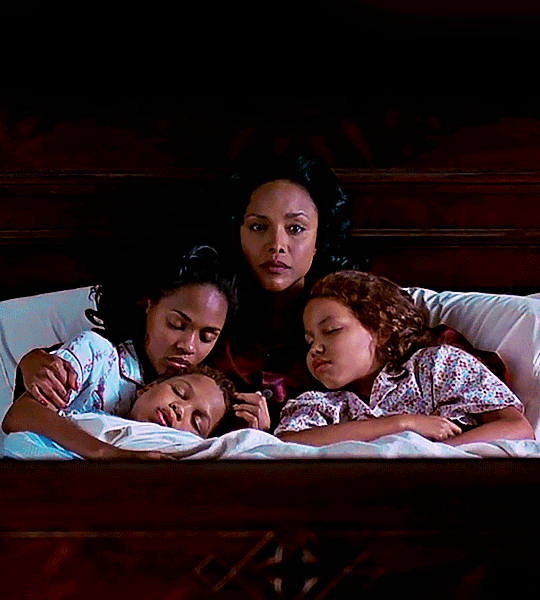
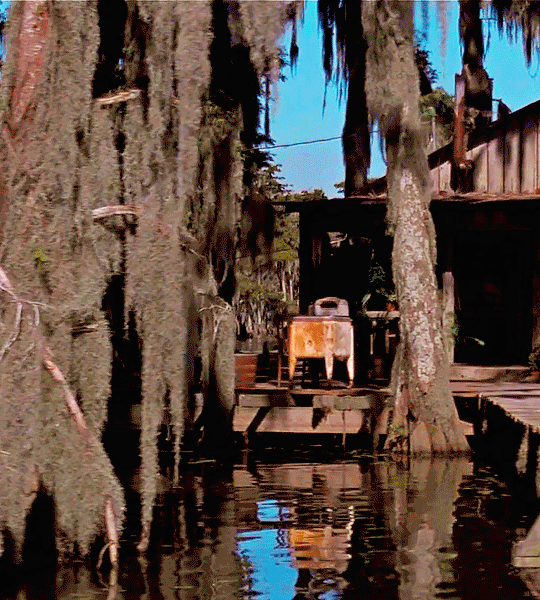

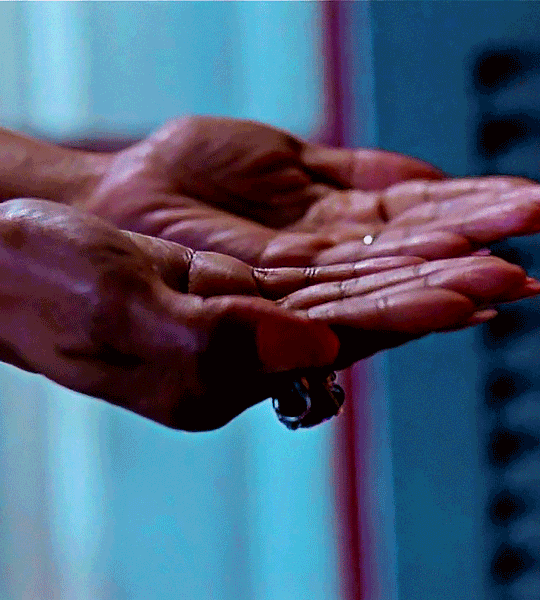
Film & TV I Think About A Lot » Eve's Bayou (1997) dir. Kasi Lemmons
"When I was your age, before I ever did the counseling, I could look at people, complete strangers, and see their whole lives so clear. But when I looked at each of my husbands, I never saw a thing. That's how it always is. Blind to my own life."
#eves bayou#eve's bayou#Kasi Lemmons#jurnee smollett#meagan good#lynn whitfield#diahann carroll#debbi morgan#film gifs#movie gifs#1997#film#black films#black women#louisiana#gifs#mygifs#cgedits#cftv#starting to get the hang of larger gifs#This film is gorgeous and has so many great lines#really influential on my storytelling style along with daughters of the dust#witches#widtcraft#voodoo#vodou#black
89 notes
·
View notes
Text
Hoodoo 101 - Jezebel Root
What is Jezebel root & why is it used in Traditional Hoodoo & Vodou?
Jezebel Root is a feminine root used in traditional Hoodoo & Vodou for dominating a wealthy man, sugar daddy or powerful person and is sometimes used for hexing or cursing. This root was named after a mythical biblical figure Queen Jezebel who belonged the Omri dynasty of the Kingdom Israel in 852 BC. As a controversial figure, she was known to be extremely cunning and ruthless, using her power to gain the upper hand by any means necessary. Historically this plant has been used by ADOS who practiced Hoodoo & Vodou, for a variety of reasons. The Jezebel stereotype was an oppressive image that was used for the sexual assault and servitude of black women during chattel slavery in the US. This root was typically associated with brothels, working girls, vaudeville/showgirls and mistresses who needed to keep their bills paid and food on their tables, by attracting abundance and docility from rich clients to better their lives as a means of survival.
Today this root is still very potent and extremely beneficial for anyone who works in any type of service industry but is typically used by women seeking a luxury lifestyle via wealthy boyfriend or sugar daddy. Typically, these roots are fed or dressed in a variety of ways and placed in mojo bags, candles or other spells to manifest their intention.
Unfortunately, in modern times authentic Jezebel root has been extremely hard to come by and the majority of Jezebel root being sold on the market is actually common garden variety mulch or cherry bark. To the untrained eye it might resemble an actual root, especially when ground up. Here is a common example of fake jezebel root that you’ll typically see being sold in spiritual shops in person or online below.

Real jezebel root should not resemble bark or any type of mulch. Depending on the maturity of the root, the main root will always have multiple smaller roots sprouting from it, unless they have been clipped or shaven off. It should always look like a root! Fake jezebel root is also easy to snap and like most bark, has a dark brown center. Real jezebel root should be somewhat flexible and have a white center, when broken open.

While this is an easy to mistake to make, many trusted shops are STILL selling fake jezebel root to their clientele. I’ve always been passionate about collecting and providing authentic high-quality goods for myself and my patrons at an affordable price. So I’ve been working on a way to provide REAL Jezebel root to the public for the past few years.
I’m pleased to announce my shop will finally be offering in limited quantity plant shares of Jezebel root to purchase during the upcoming spring season of 2023 under our new indoor grow system.
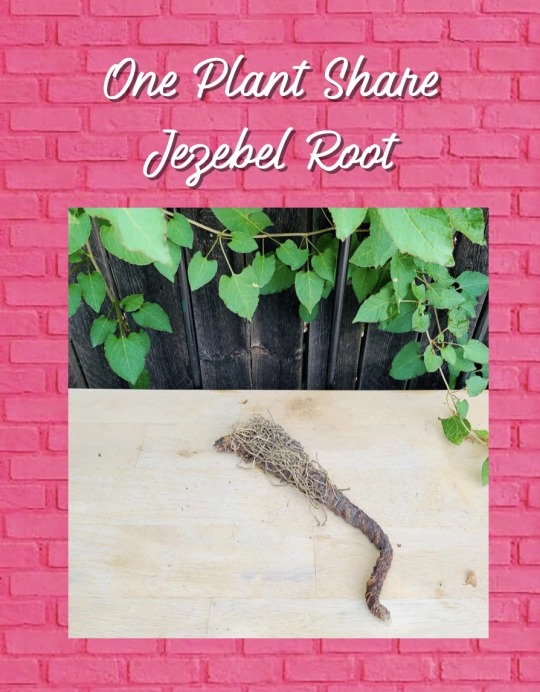
Click HERE to Shop authentic Jezebel Root
Limited to one per person. We also offer Shop Installments via Affirm and accept PayPal & Apple Pay.
#hoodoo community#witches of color#jezebel#jewitchery#the love witch#hoodoo history#hoodoo#vodou#voodoo#pagan community#witches of instagram#love magick#love spells#beauty spells#striptok#black glamour#spoiled gf#luxe life#sugar bowl#sugarbabytips#high maintenance#sugaring#luxury#hypergamy#sw#304#black femininity#black self care#hbfsociety#blackluxury
159 notes
·
View notes
Text
“But the show is also mocking Christianity and y’all aren’t calling that out.” Quite frankly, as a Christian I don’t care. I nor my belief in God is that fragile that it being depicted the way it is is gonna cause me to cry. What I do care about though, is the constant disrespect and disregard shown to Black fans and Black ppl in general who are calling out the fact that vodou, A CLOSED PRACTICE, is being used in a harmful way in Hazbin Hotel. Nobody cares if you don’t believe in God(s). We really don’t. Utilizing parts of a practice, which again is closed, after people told you not to is unacceptable. A belief system that originated in Africa and later spread due to slavery that is used for healing and to help people should not be further demonized for a show. At all. I’ve said it before: I’m not a practitioner but I do believe a lot of y’all, including Vizziepop, are about to fly too close to the sun and find out why vodou should not be used in this way.
31 notes
·
View notes
Text
A death rite in Haitian Vodou
Here is a rare look at the publicly viewable portion of desounay/desounen, which is the first rite after a houngan, manbo, or other vodouizan passes. Unfortunately, this was a rite done on behalf of the death of a very well known and well respected houngan in Jacmel, Haiti who died unexpectedly this morning. This is difficult to watch, with lots of crying and expressions of grief.
youtube
The video begins with the procession, which has likely started at the home of the houngan (Woodson Antoine, ki di Gwètòde Plenipontansyè), where he passed, and is leading into the temple where Houngan Sonson was initiated. The procession ends as the rest of the desounay is completed behind closed doors. After, folks who have arrived gather to hear Houngan Woodson's papa kanzo speak, and then the videographer shares the news that Houngan Woodson has passed and shares what details were available; that he has been in ceremony just hours earlier with many of the people present, had not been well and had many health issues, had been encouraged to go to the hospital, and then went home, where he passed due to breathing difficulties. By the time an ambulance was found, he had already gone. The videographer compares desounay to the Catholic rite of extreme unction, which is aimed at allowing someone sick to pass to eternity with the blessings of their God and forgiven of their sins. Desounay is a little different than that, as it is only completed after death.
The desounay is completed as soon as possible after death is realized; this is the first ceremony that begins to separate our various soul pieces to go where they must so that we, our lwa, and our descendants can have peace after we pass. It is preferable that this ceremony is done before the body is taken from the home to the morgue or funeral home. In this case, you can see how quickly it was put together; it is happening very early in the morning, pre-9AM, and folks have clearly come directly from ceremony or their homes in a rush, you can see that they have put their white clothes on over other clothes or black and purple clothes from the Gede ceremonies they were attending. This has happened so quickly that there has not been time to prepare the temple or really even the community; Houngan Woodson was extremely well known in Jacmel and in Haiti at large due to his position as gwètò and not everyone was able to come in the moment to share in the grief. His bowoum and traditional internment will undoubtedly be huge.
This is a huge loss. While Haitian Vodou professes no central authority figure(s), a gwètò is a sort of regional coordinator that takes on the responsibility of watching over the community/communities in his or her region. A gwètò might mediate disputes, help a new temple start up, and represent the region throughout the country. Houngan Woodson took his position seriously and attended just about every ceremony in the area, even if he could only go for awhile. I personally benefitted from his intercession when there were local issues my husband needed help with, and I knew Houngan Woodson to be a kind, thoughtful, and caring individual who was always pleased to see me and hear how I was.
This has been a very introspective Gede season for me; Gede has had me sitting and reflecting on things that I will write about soon. What I have thought about today in thinking about this particular death is that access to healthcare is a liberation issue. While only Bondye knows our time and we ask to only be taken at our right time, had Haiti had more equitable access to both emergency medical care in that someone could have called for help and Houngan Woodson could have gone to a hospital that was staffed and had medical equipment, and regular healthcare that could have provided ongoing support for his medical issues as we know in many other parts of the world, perhaps his death could have been avoided. If liberation was fully realized in Haiti, deaths from things we take for granted as minor annoyances, like asthma, strep throat, high blood sugar, and similar, would be a thing of the past.
Woukoukou, yon gwo pyebwa te tonbe. May Houngan Woodson awaken in the company of his ancestors and his lwa in Alada, and may his friends, family, and loved ones find comfort in his memory.
43 notes
·
View notes
Text

https://chng.it/8xqLq2dvsn
#asteroids#astrology#zodiac#western astrology#astrologer#orisha#santería#isese#vodou#voodoo#spiritism#spiritualism#paganism#polytheism#petition
32 notes
·
View notes
Text
Here’s a dump of some of the concept art I’ve made for my Homebrew D&D work I’m working on!
In the Withered Dreamlands (working title), the gods that created the world have all perished. They destroyed each other in a divine war that left the planet forever changed and filled with magic.
The tone of the world is whimsical high fantasy. My main inspirations are stuff like Adventure Time, Studio Ghibli movies, the Legend of Zelda, ect.

Photoslugs are gigantic slugs that are often seen in herds grazing on the planes. They graze not on the grass, but on the sunlight as they photosynthesize. I based these guys on irl leaf slugs :)
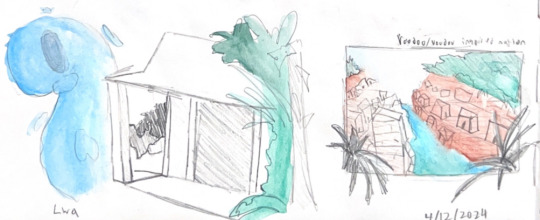
Here’s some concept sketches for a Haitian Vodou inspired nation in my world that I’m currently fleshing out. I’m really in love with what I’m coming up with so far.

Mossbacks are giant marine mammals that grow plants on their backs. I don’t have much on these guys yet but they’re based on IRL manatees!
#trrpg#d&d#sketchbook#art#pathfinder#homebrew#worldbuilding#dnd#dnd art#d&d art#dm#GM#dungeon master#game master#slug#manatee#voodoo#vodou#haitian vodou
13 notes
·
View notes
Text
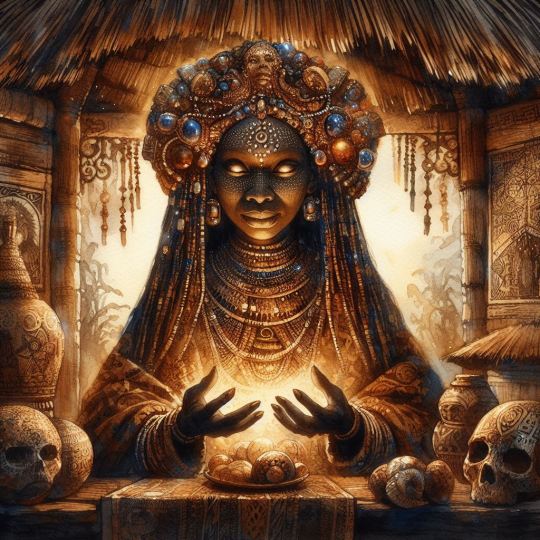
15 notes
·
View notes
Text

Gerard Valcin (Haitian, 1924-1988) - Vodou Ceremony Around Tree (1980s)
94 notes
·
View notes